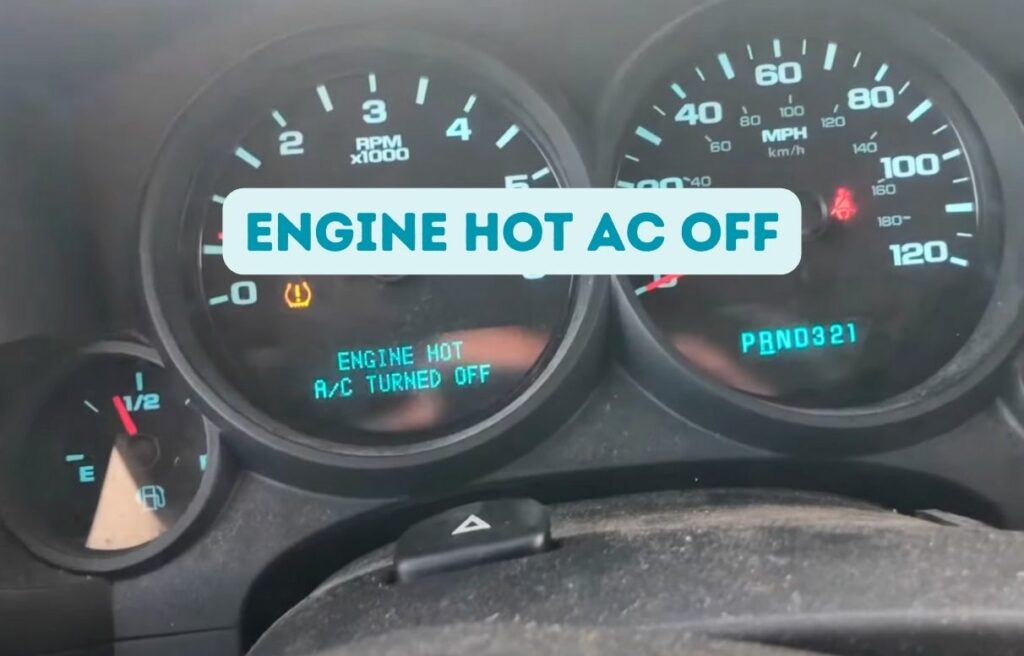If you own a car and have encountered the frustrating issue of the “Engine Hot AC Turned Off” warning light, worry not. This common problem can be addressed with a simple on-the-road fix. In this guide, we’ll explore the symptoms, identify potential causes, and walk you through a quick solution.

engine hot ac off can you still drive?
No, you should not drive your car if it says “engine hot AC off.” The warning means that your engine is overheating, and if you keep moving, you can cause extensive damage to your car. Overheating can lead to a cracked cylinder head, blown head gasket, or even seized engine. These are all very expensive repairs, and they can even total your car.
What does it mean when a car says “engine hot AC off”?
The “Engine Hot AC Off” warning light is an indication that your vehicle’s engine is overheating and the air conditioning system has been disabled to protect the engine from further damage. This light typically illuminates when the engine coolant temperature reaches a dangerously high level.
When the engine overheats, the coolant temperature sensor detects the high temperature and sends a signal to the engine control unit (ECU). The ECU then triggers the “Engine Hot AC Off” warning light to alert the driver and takes precautionary measures to prevent engine damage.
Disabling the AC system reduces the load on the engine and diverts energy away from the AC compressor, allowing the engine to focus on cooling itself down. The AC system generates heat as a byproduct of its operation, and turning it off helps to reduce the overall heat load on the engine.
what causes engine hot ac off
There are several potential causes for an “Engine Hot AC Off” warning light. These include:
Low coolant to the reservoir
Coolant is vital in keeping the engine cold to operate perfectly. A water pump pushes the coolant through different channels of cylinder blocks. As it passes through, it absorbs the hotness from the engine and makes the engine cool.
Now if the coolant level is low, it cannot cool down the engine, which raises the temperature in the engine, leading to overheating. It ultimately shows up on the car dashboard.
- Open the hood when the engine is cool
- Locate the coolant reservoir. It looks like a translucent plastic tank.
- Check the coolant level marked on the side – F(full) or L(low)
- You can check it by shaking it a little bit
Blown head gasket
Does the engine overheat often?
If so, chances are high that the head gasket has blown away. A broken head means the engine has to work harder to generate power. More work means more heat which results in overheating. Some common symptoms of a broken gasket are,
- Constant overheating
- Fluid leakage from the engine
- Low cooling
- Bubbles present in radiator or tank
- White exhaust smoke
Clocked Thermostat valve
Sometimes, the problem is with the thermostat. The role of the Thermostat is to coolant fluid flow when the engine reaches a certain heat level. When the thermostat is stuck to open, it fails to let the coolant flow to the reservoir, raising the temperature.
Start the engine and wait until it gets idle. See the radiator filler neck to see the flow of the fluid. If the fluid is not flowing, the problem is with the Thermostat valve.
Damaged radiator fan
A damaged radiator fan can be responsible for this problem. The radiator fan lets the hot air out. A damaged fan cannot let the air out, which leads to an overheating engine.
Coolant temperature sensor (ECT) error:
The ECT detects the coolant temperature and sends a signal to the ECU. If the ECT is faulty, it may provide inaccurate readings, leading to the premature disabling of the AC system.
Faulty cooling fan:
The cooling fan plays a crucial role in drawing air through the radiator to cool the coolant. If the fan isn’t working correctly, it can’t effectively dissipate heat from the engine.
Water pump failure:
The water pump is responsible for circulating coolant throughout the cooling system. If it fails, coolant circulation is disrupted, leading to overheating.
how to Fix engine hot ac off
Symptoms: The warning light appears, indicating engine overheating, and the AC stops blowing cold air. Oddly, the temperature gauge shows no reading, behaving as if the engine just started, even in warm conditions.
Diagnostic Steps:
- Check Coolant Levels: Ensure your coolant levels are sufficient. Shake the coolant reservoir to observe movement, indicating an adequate coolant supply.
- Inspect Radiator Hoses: Verify the temperature of the top radiator hose; it should be hot but touchable. The bottom hose, releasing cooled fluid, should be cooler. If the bottom hose is excessively hot, it signals potential engine overheating.
- ECM Fuse Inspection: Under the hood, locate the Engine Control Module (ECM) fuse. Refer to your vehicle’s manual to identify the correct fuse (commonly labeled as ECM or ECM Battery). In my case, it’s labeled as number 12.
⚠️ Potential Dash Warning:
|| How do I fix the “Check Fuel Cap Light”?
|| Depress Brake Pedal Warning Light
how to reset engine hot ac off
- With the engine off, remove the ECM fuse for approximately 10 seconds.
- After the brief pause, reinsert the fuse.
- Start the engine and monitor the temperature gauge. Ensure it rises to a normal level, around 210 degrees.
- Check the AC functionality by turning it on. Confirm that the compressor engages, and the warning light stays off.
Verification: A positive sign that the issue is resolved is the illumination of the AC indicator light when the air conditioning is turned on. Additionally, the temperature gauge should remain stable around 210 degrees.

Leave a Reply